In recent years, two-wheelers have headed in the direction of intelligent connection and intelligent driving, which has been accompanied by consumption upgrade, and mature applications of big data, artificial intelligence (AI), Internet of Things, 5G and other technologies. In the early stage of intelligence, it is necessary to transfer technology from smart products and intelligent vehicles to MCUs, chips, big intelligent screens, automotive electronics, software and operating systems. Based on the successful experience in vehicle intelligence, some automakers therefore have begun to deploy two-wheelers in hope of expanding new business amid the automotive market saturation.
1. Electric two-wheeler intelligence
Electric two-wheelers use IoT technology for remote unlocking and mobile APP interconnection, AI big data computing for higher battery safety and precise range, and GPS/Beidou positioning technology for anti-theft, which has been a standard configuration in high-end brands of top manufacturers. Internet brand electric vehicle manufacturers such as Niu Technologies and Segway-Ninebo have even started installing cameras, ultrasonic sensors and other sensors to enable riding assistance functions such as ACC and collision warning to gain differentiated competitive edges.
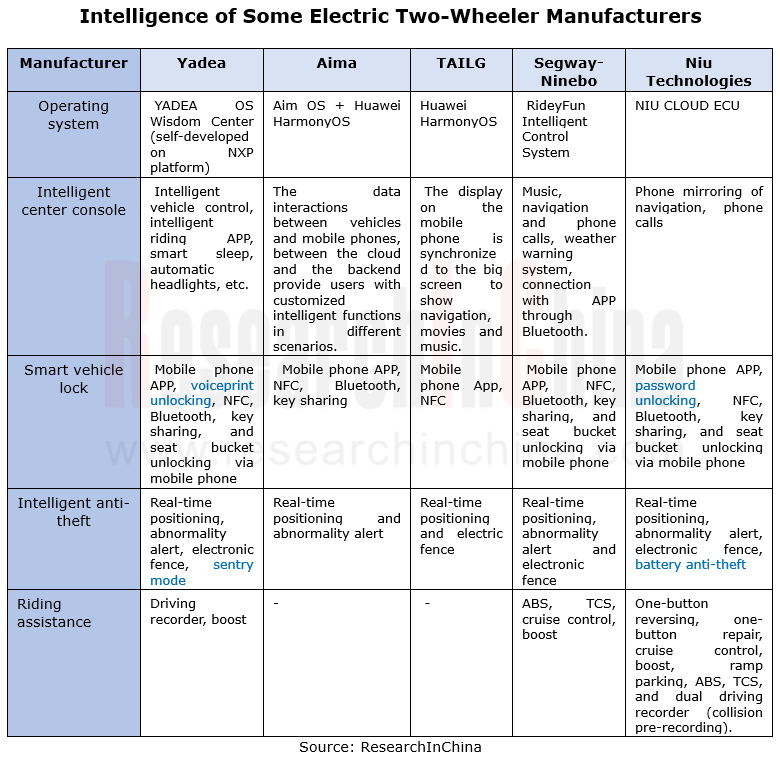
2. Motorcycle intelligence
Motorcycles are becoming "intelligent", and telematics, adaptive cruise control (ACC), forward collision warning (FCW), blind spot detection (BSD) and other functions are finding their way into the motorcycle industry.
For example, in September 2023 Qianjiang Motorcycle released QJ PILOT, an AI-driven riding assistance system which combines intelligent hardware and software. It has such functions as monitoring, warning, and safety protection, and also enables language communication between people and vehicles through voice interaction to complete audio navigation, vehicle control and other tasks.
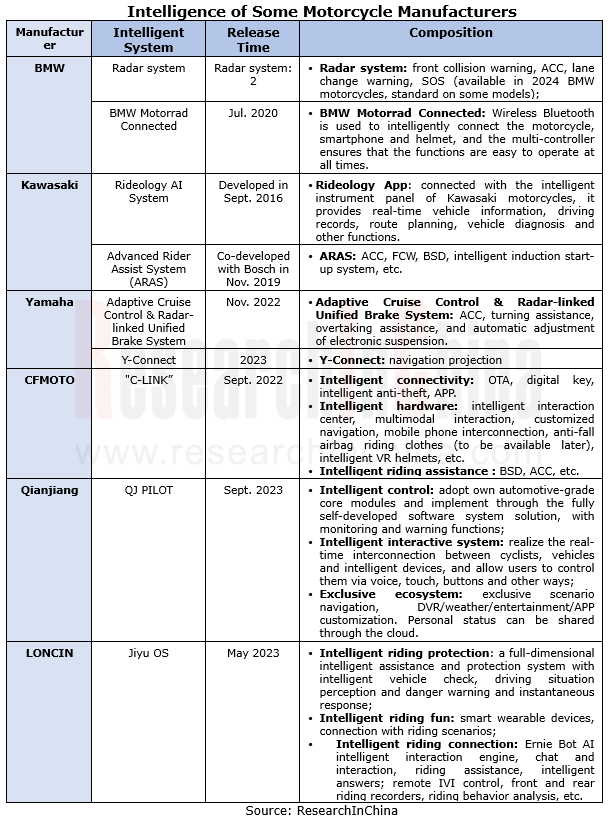
3. Automotive Tier 1 suppliers have dabbled in the two-wheeler industry.
Bosch has started developing ABS for motorcycles since 1984. Up to now, its products have covered motorcycles and electric two-wheelers. Bosch's two-wheeler products include:
Sensors (radar, IMU, wheel speed sensor, etc.)
Motorcycle stability control (MSC)
Anti-lock braking system (ABS)
Advanced rider assist system (ARAS)
Integrated interconnection (cluster is connected with helmet, mobile phone, etc.)
B2V (information interaction between motorcycle and automobile)
mySPIN APP
Electric vehicle products (hub motor and drive control unit)
In addition to Bosch, Huawei, Qualcomm, Cerence and ABUP among others that are successful in vehicle intelligence also have set foot in the two-wheeler industry in recent years.
Huawei: In 2021, SUNRA became a partner of Huawei HarmonyOS, and officially launched the industry's first electric vehicle connected with HarmonyOS. In 2022, Huawei continued to use HarmonyOS as a stepping stone to expand its main business to the field of electric bicycles. In 2023, TAILG and Aima launched products equipped with HarmonyOS.
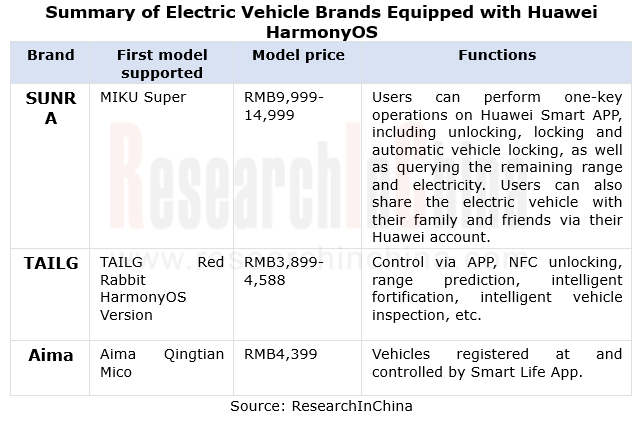
Qualcomm: In May 2023, Qualcomm released a digital chassis supporting two-wheelers, providing connected services for two-wheelers. In September 2023, Qualcomm expanded its Snapdragon Digital Chassis portfolio with the introduction of two new platforms, QWM2290 and QWS2290, using the latest technologies of Snapdragon Cockpit Platform, Snapdragon Automotive Connected Platform, and Snapdragon Cloud Connected Digital Services to provide technical support for motorcycles, electric vehicles and other fields. Currently, two-wheeler manufacturers, Tier 1 suppliers, module vendors, etc. have adopted these two platforms to build related models. In November 2023, Valeo and Qualcomm cooperated on innovation for the 2-wheeler and 3-wheeler segments in India. These collaborative efforts are an extension of the two companies’ long-term working relationship to deliver advanced computing units for telematics and advanced driver assistance systems (ADAS) for software-defined vehicles (SDVs).
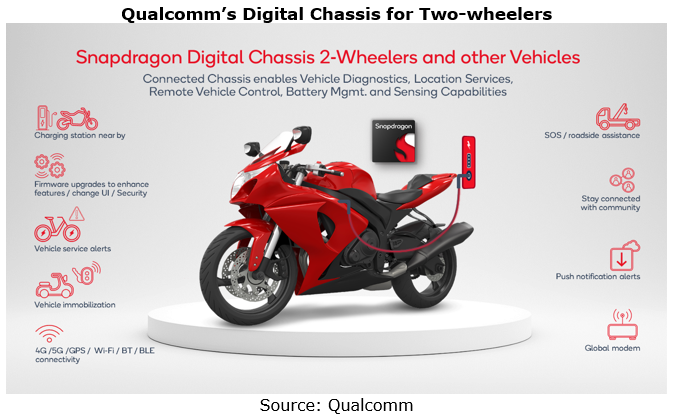
Cerence: Cerence concentrates on building AI intelligent voice interactive assistants for the automotive industry. In July 2021, it cooperated with Visteon to dabble in the two-wheeler field. From 2022 to 2023, it provided voice interactive products for motorcycle brands such as Qianjiang, CFMOTO and LONCIN.
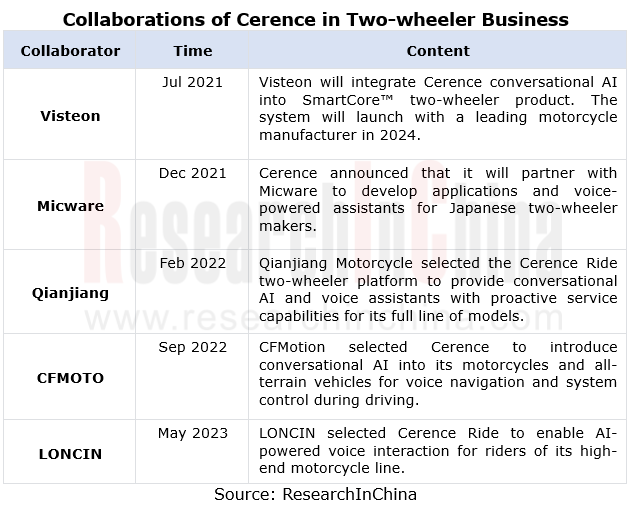
At present, the intelligent driving of two-wheelers features warning, and will have control functions (motorcycle self-balancing, lane keeping assist, emergency avoidance, etc.), so high-performance chips, cameras, radar and other hardware will be installed. Moreover, in the future, ever more two-wheelers will have interconnection functions, such as intelligent interconnection, OTA, voice interaction, face recognition and gesture control.
Automotive Vision Industry Report, 2025
Automotive Vision Research: Average Camera Installation per Vehicle Reaches 5.2 Units, and Front-View Tricam Installation Exceeds 1.2 Million Sets.
From January to September 2025, the total installa...
Automotive Infrared Night Vision System Research Report, 2025
Automotive night vision research: The rise of infrared AEB, with automotive infrared night vision experiencing a 384.7% year-on-year increase from January to September.
From January to September 2025...
New Energy Vehicle Cross-Domain (Electric Drive System and Powertrain Domain) Integration Trend Report 2025-2026
Electric Drive and Powertrain Domain Research: New technologies such as three-motor four-wheel drive, drive-brake integration, and corner modules are being rapidly installed in vehicles.
Electric dri...
Analysis on Desay SV and Joyson Electronic's Electrification, Connectivity, Intelligence and Sharing, 2025
Research on Desay SV and Joyson Electronic: Who is the No.1 Intelligent Supplier?
Both Desay SV and Joyson Electronic are leading domestic suppliers in automotive intelligence. "Analysis on Desay SV ...
OEMs and Tier 1 Suppliers' Cost Reduction and Efficiency Enhancement Strategy Analysis Report, 2025
ResearchInChina released the "OEMs and Tier 1 Suppliers' Cost Reduction and Efficiency Enhancement Strategy Analysis Report, 2025", summarizing hundreds of cost reduction strategies to provide referen...
Automotive Fixed Panoramic Sunroof and Smart Roof Research Report, 2025
With the intelligent application of car roofs as the core, this report systematically sorts out a series of new products such as fixed panoramic sunroof/openable sunroof, ceiling screen, roof ambient ...
Automotive-Grade Power Semiconductor and Module (SiC, GaN) Industry Research Report, 2025
SiC/GaN Research: Sales volume of 800V+ architecture-based vehicles will increase more than 10 times, and hybrid carbon (SiC+IGBT) power modules are rapidly being deployed in vehicles.
Sales volume o...
Cockpit Agent Engineering Research Report, 2025
Cockpit Agent Engineering Research: Breakthrough from Digital AI to Physical AI
Cockpit Agent Engineering Research Report, 2025 starts with the status quo of cockpit agents, summarizes the technical ...
Prospective Study on L3 Intelligent Driving Technology of OEMs and Tier 1 Suppliers, 2025
L3 Research: The Window of Opportunity Has Arrived - Eight Trends in L3 Layout of OEMs and Tier 1 Suppliers
Through in-depth research on 15 OEMs (including 8 Chinese and 7 foreign OEMs) and 9 Tier 1 ...
China Commercial Vehicle IoV and Intelligent Cockpit Industry Research Report 2025
Commercial Vehicle IoV and Cockpit Research: The Third Wave of Passenger Car/Commercial Vehicle Technology Integration Arrives, and T-Box Integrates e-Call and 15.6-inch for Vehicles
I. The third wav...
Intelligent Vehicle Electronic and Electrical Architecture (EEA) and Technology Supply Chain Construction Strategy Research Report, 2025
E/E Architecture Research: 24 OEMs Deploy Innovative Products from Platform Architectures to Technical Selling Points
According to statistics from ResearchInChina, 802,000 passenger cars with domain...
Research Report on Intelligent Vehicle Cross-Domain Integration Strategies and Innovative Function Scenarios, 2025
Cross-Domain Integration Strategy Research: Automakers' Competition Extends to Cross-Domain Innovative Function Scenarios such as Cockpit-Driving, Powertrain, and Chassis
Cross-domain integration of ...
China Autonomous Driving Data Closed Loop Research Report, 2025
Data Closed-Loop Research: Synthetic Data Accounts for Over 50%, Full-process Automated Toolchain Gradually Implemented
Key Points:From 2023 to 2025, the proportion of synthetic data increased from 2...
Automotive Glass and Smart Glass Research Report, 2025
Automotive Glass Report: Dimmable Glass Offers Active Mode, Penetration Rate Expected to Reach 10% by 2030
ResearchInChina releases the Automotive Glass and Smart Glass Research Report, 2025. This r...
Passenger Car Brake-by-Wire (BBW) Research Report, 2025
Brake-by-Wire: EHB to Be Installed in 12 Million Vehicles in 2025
1. EHB Have Been Installed in over 10 Million Vehicles, A Figure to Hit 12 Million in 2025.
In 2024, the brake-by-wire, Electro-Hydr...
Autonomous Driving Domain Controller and Central Computing Unit (CCU) Industry Report, 2025
Research on Autonomous Driving Domain Controllers: Monthly Penetration Rate Exceeded 30% for the First Time, and 700T+ Ultrahigh-compute Domain Controller Products Are Rapidly Installed in Vehicles
L...
China Automotive Lighting and Ambient Lighting System Research Report, 2025
Automotive Lighting System Research: In 2025H1, Autonomous Driving System (ADS) Marker Lamps Saw an 11-Fold Year-on-Year Growth and the Installation Rate of Automotive LED Lighting Approached 90...
Ecological Domain and Automotive Hardware Expansion Research Report, 2025
ResearchInChina has released the Ecological Domain and Automotive Hardware Expansion Research Report, 2025, which delves into the application of various automotive extended hardware, supplier ecologic...